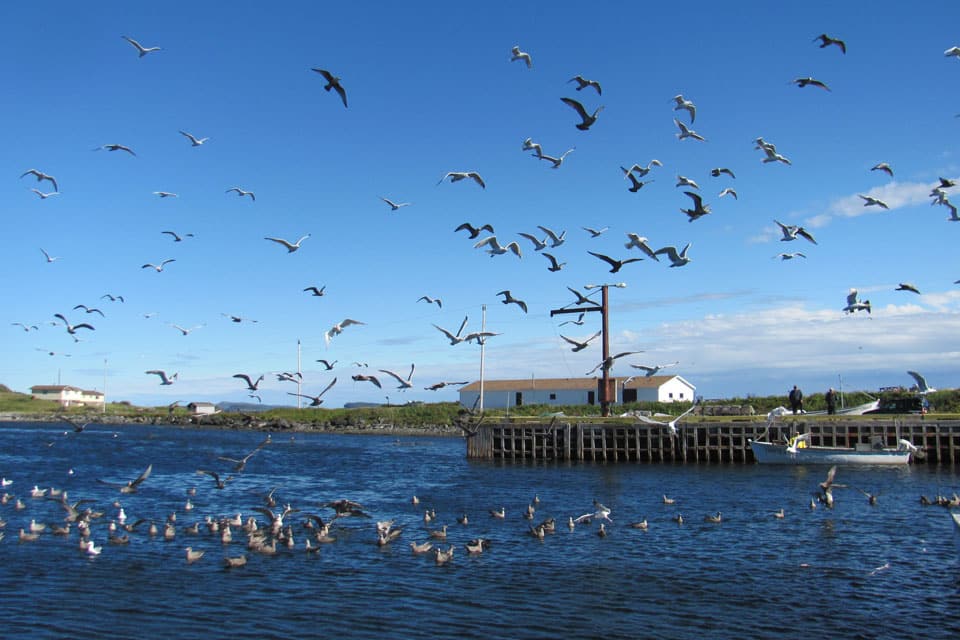
The very top of the Northern Peninsula of Newfoundland, at almost 52 degrees of North latitude, is a chilly place all year ‘round. There’s not a lot of trees, and the ones there are cannot be called opulent. It’s windy and rocky and cloudy and spends most of the winter frozen over. The locals love that, since it makes traveling over the sea a lot easier. After all, there’s no waves in sea ice, you can drive your pickup truck on it, and there’s no speed limit. It’s also the place where the vikings first came ashore, and it’s no wonder they aren’t there now—without pickup trucks, winter would get pretty boring.
Our experience there was anything but boring, but then, it wasn’t winter quite yet. I wouldn’t normally poke my nose out of a harbor with a gale warning on, but there didn’t ever seem NOT to be. The question was just whether we could get to the next spot before the gale did. Our first sally out of Quirpon into the Straits of Belle Isle was to go just ten miles to Ship Cove, underneath Cape Onion, to tie up to the lee of the public wharf and be grateful to spend three days there in the rain while a roaring Sou’Wester did it’s thing. Cape Onion CoastThere was no grocery store, but the girls found some potatoes growing wild to dig, and a local gave us some more potatoes out of his patch. Of course, we still had a whole sack of potatoes we’d got in St Anthony, but freshly dug potatoes are delicious, and washing them uses up time. We also killed time by cutting up firewood we’d gathered in Quirpon, and had a couple of fires to dry things out and make the cabin cozy.
After the gale blew itself out, as if a reward for our patience, we got an SE wind—that meant an offshore breeze, the sailor’s best friend that lets him make good time without kicking up waves to make him spill his coffee. There was also a fair tide, and we made a long day of it, all the way down the Straits of Belle Isle with a quiet sea and a gentle wind on the quarter. We even, for the first time in days, caught a glimpse or two of the sun. All told, Ganymede averaged seven knots, and it was astonishing to arrive fifty miles later in Savage Cove with plenty of daylight to hitch a ride to the store, and for the girls to put on snowsuits and roam the beach for scallop shells.
There was a mini-gang of local boys on dirt bikes who, having nothing more interesting to do, rode out to the wharf to check out Ganymede. They weren’t the sharpest knives in the drawer, since while I talked to them they pointed out where they lived, then proceeded to see who could hit the skylight with the rusty broken chain littering the wharf after I went below. After I emerged in righteous indignation and reminded them that they themselves had told me where they lived, the rain of rubbish dried up.
Though it had changed with each successive broadcast, the weather forecast sounded safe enough next morning to get across the Straits to the mainland side. Accordingly we took off, foggy rain notwithstanding, and were rewarded by a fast and pleasant sail under reefed main & stay’sl (practically a calm day, for these parts) to the edge of Quebec, just across the border from Labrador. It was strange to think, looking back into the fog, that we were leaving Newfoundland behind at last. We had discovered in it an almost untouched jewel of a cruising ground—unique scenery, incredible people, a summer not sweltering in frightful heat—it was cruising as different from cruising the tropics as could be. Not that we dislike tropical cruising, but it had certainly been a refreshing change, and more of an adventure than the beaten Caribbean and Pacific paths. We had at no time feared piracy or theft, never had wanted for a ride to the gas station or grocery store, suffered from no language barriers, and hadn’t been allowed to pay a dime for mountains of fresh seafood. Yes, a wonderful place indeed but were were leaving none too soon. Fall was advancing, and we still had hundreds of miles of the coast of Quebec, about which we knew nothing yet, to traverse before November.
As Ganymede chugged gently into her first mainland anchorage, a rock-studded harbor just around the corner from Blanc Sablon, I almost wished we could have stayed in Newfoundland. But part of cruising is getting along, leaving behind all the magical places but taking the memories of them with you, treasuring them even as you look forward to the next mysterious and undiscovered coast. Our next coast lay before us now, curving gently southwest toward Cape Whittle, then straight west to Sept Iles, where it finally drops below 50 north to form the northern bank of the great St Lawrence River. I only hope we find this next leg as wonderful as the last.








